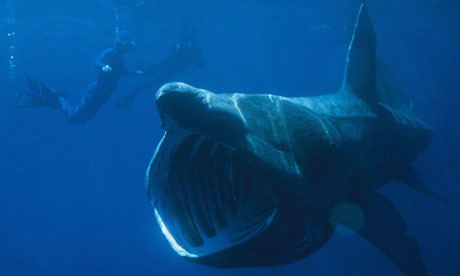
At times heavier than an elephant and more than 10 metres long, seeing a basking shark is an unforgettable underwater experience
Scotland may be one of the best places in the world to spot basking sharks, according to a survey by the Wildlife Trusts. Its Basking Shark Project recorded 120 ‘baskers’ over a ten-week period in summer 2004 – 106 of them were in Scottish waters.
Essentially an industrial-sized mouth with fins, the basking shark isn’t one of nature’s most attractive creatures. But it has its own special appeal. For a start, it’s big. It’s the second-largest fish in the sea (after the whale shark) and by far the largest fish in the North Atlantic. It can weigh more than an African elephant and is reputed to grow to lengths of ten metres or more.
It spends most of the summer cruising near the surface, with its mouth wide open, capturing plankton with the help of special sieves in its enormous gill slits. Experts believe that this plankton is being pushed farther north in the ocean currents, which may explain why more sharks are visiting Scottish waters than ever before.
Unlike most other sharks, ‘baskers’ are readily seen from boats and from shore. The tell-tale sign is a huge dorsal fin, the upper lobe of a tail fin or even a snout protruding above the surface.
The best way to see them is by snorkelling. These giant feeding machines often pass within a couple of metres of snorkellers. An underwater encounter like this is one of the world’s great wildlife experiences. And it’s safe– basking sharks are gentle giants. Give them enough personal space and they’ll treat you with the same respect.
Unfortunately, they’re not the easiest fish to find. They are widely distributed in cool, temperate waters worldwide, mainly close to shore, but they are rare. Huge numbers have been killed for their meat and oil (in the past 60 years, 105,000 have been killed in the north-east Atlantic alone) and, although protected in some countries (including England and Wales), they’re now being targeted to feed the demand for shark-fin soup in parts of Asia.
But we are very lucky in the UK because we have several of the world’s hotspots. Basking sharks move into our coastal waters during the spring and summer (they travel far and wide in deeper waters during winter) and turn up with surprising regularity in a handful of locations along our western seaboard.
Between 1987 and 2004, the Marine Conservation Society’s Basking Shark Watch received 6,511 reports of sightings of over 21,000 sharks from divers, fishermen, sailors and coastal walkers. Their results show clear evidence of five key locations: Cornwall and Devon (especially around Land’s End, the Lizard peninsula and the waters off Plymouth); the Isle of Man; the waters off Strangford Lough in Northern Ireland; around Arran, in the Firth of Clyde; and the Inner and Outer Hebrides.
Baskers tend to move in from the west, appearing in Cornwall from mid-April (if the previous winter was warm) or mid-May (if it was particularly cold), and in northern Scotland from late July onwards. Sea Life Surveys, Mull and Porthkerris Divers in Cornwall offer shark-watching trips. If you’re not successful the first time, try again. It’ll be more than worth the effort.
For more information check out the Marine Conservation Society, the Wildlife Trusts, and the European Basking Shark Identification Project.